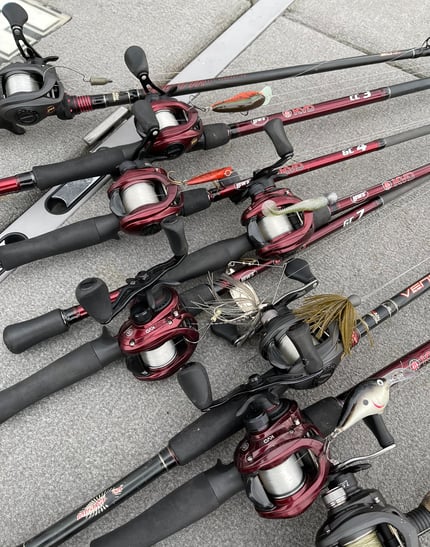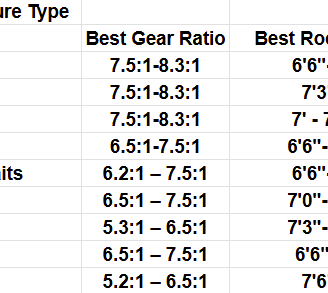Choosing a Baitcasting Rod and Reel Setups for each Lure Category
As Bass fishing has become more scientific and technological so has our choices become just as abundant. Think about it, Rods and Reels have at least 8-10 individual options. Rods have heights, action, power. Reels have gear ratio, bearing quantity, and retrieve side. Here is a quick post with a great foundational guide to understand and choose the right setup for any lure.
BASS FISHING
Chris Pentz
3/14/20254 min read


As an experienced angler these options are memorized. Now when looking for the correct setup, all I have to do is review my mental checklist. This article will help you establish this memory foundation so it is one less complicated decision you need to think about. The great thing is it is not all that complicated once you understand the basic principles. But with understanding you can really improve your "Fishskillz"!


Rods
Fishing rods have many applications according to what size the rod is. The size range can be anywhere from 6’6’ to 8’(main range). Now most of the time this increases by 6” for the next rod length. 6’,6'6" etc. all the way up to 8’. So right here we have at least 6 if not more rod lengths to choose from. I’d say the most common length range is 6’6”-7’6”. Right now in my rod locker I have 15 setups and 85% are in this range. Here is a great foundation source to help you choosing the right rod for each lure category:
Short Rods (6’6” – 7’0”)
Best for: Close-quarters fishing, skipping docks, finesse techniques
Common Techniques: Jerkbaits, topwater poppers, finesse spinning setups, small swimbaits
Pros: Better accuracy, good for short casts, bank fishing
Cons: Less casting distance, not ideal for heavy cover
Medium-Length Rods (7’0” – 7’6”) (Most Common for Bass Fishing)
Best for: Versatile applications (crankbaits, jigs, Texas rigs, spinnerbaits, chatterbaits)
Common Techniques: Most techniques, including plastics, crankbaits, jigs
Pros: Good balance of accuracy and distance
Cons: May be to big for bank fishing
Long Rods (7’6” – 8’0”)
Best for: Heavy cover, long casts, leverage for hooksets
Common Techniques: Flipping, punching, deep cranking, swimbaits, A-rigs
Pros: Better hook-setting power, longer casts, good for heavy cover
Cons: Can be harder to maneuver in tight spaces
Reels
Reels thankfully have a little less variety then Rods. The most important factors you want to consider when choosing a reel is the retrieve side and the gear ratio.
The Retrieve side is what hand you will be turning the crank with. This has always intrigued me when asking a person why they run the crank lefty or righty. There is no really good reason except whatever side you feel comfortable doing it on. For me, I like cranking with my left hand/weaker side so my right hand/stronger side can hold the rod and fit the fish. I am right handed. I know plenty of righties that do it the opposite way with success so there really is not a right way. Just whichever way you are comfortable. Now that I got that out of the way let me give a good memory foundation for choosing a reel. We are going to stick with the “Low Profile Design” baitcasting reels.
Low-Profile Baitcasting Reels (Most Common for Bass Fishing)
Best for: Versatility, comfort, and precision casting
Common Techniques: Jigs, Texas rigs, crankbaits, spinnerbaits, topwater
Pros:
Ergonomic and lightweight
Excellent casting accuracy
Faster retrieves available
Cons:
Can be prone to backlash if not adjusted properly
Limited line capacity compared to round reels
This type of of reel will be used almost all of the time with some exceptions we wont get into.
Now the next and most important step in choosing the right reel setup is GEAR RATIO! This is really I feel the most important choice to make out of the decisions. I truly is what makes the lure move. Mimicking correctly the bait you are trying to imitate can be all the difference.
Understanding Gear Ratio in Baitcasting Reels
Gear ratio in baitcasting reels refers to how many times the spool rotates with each turn of the handle. It’s expressed as a ratio, such as 6.8:1, meaning the spool turns 6.8 times for every full handle rotation. This affects your retrieval speed and determines the reel’s best application for different fishing techniques.
Low Gear Ratio (5.3:1 – 6.5:1): These reels retrieve slower, providing more torque. They’re ideal for deep crankbaits, large swimbaits, and big jigs where a slower presentation keeps the lure in the strike zone longer.
Medium Gear Ratio (6.5:1 – 7.5:1): The most versatile option, balancing speed and power. Perfect for spinnerbaits, Texas rigs, and topwater lures, this ratio allows for an all-around effective retrieve.
High Gear Ratio (7.5:1 and above): These reels offer fast retrieval, making them great for techniques requiring quick line pickup, like pitching, flipping, and working jerkbaits.
Choosing the right gear ratio depends on your lure choice and fishing conditions. Slower ratios provide more control and power, while higher ratios help cover water quickly and react faster to bites. Having multiple gear ratios in your arsenal ensures you’re ready for any fishing situation!
Finally, I have created a small chart below to help visually guide you. This has the basic information you will need to establish a foundation for knowing what Rod and Reel setup works with what Lure. Hopefully you will notice that many lures can be complimented with the same rod and reel as another. My Favorite choice for an all around setup is the 7'0" Rod MH Action with 7.5:1 Reel. Good Luck Fellow Fishing Friends!! Go Catch'em!
